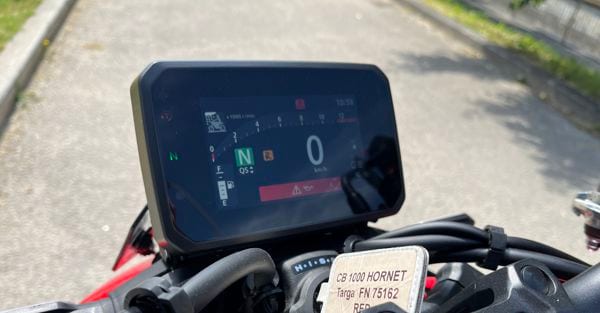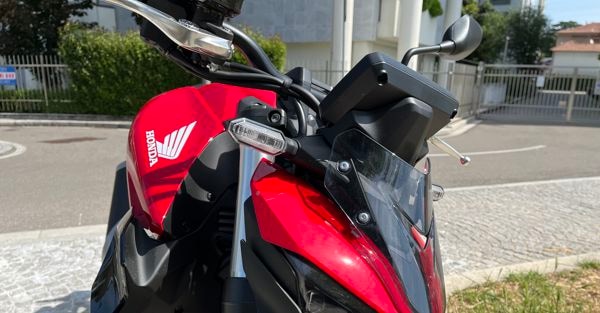Honda Cb1000 Hornet, how the Japanese maxinaked “stings”!

“Hornet” (“hornet” in English) is a name well known to Honda enthusiasts and beyond: the model was born in 1998 with a 599 cc, 96 hp four-cylinder and a nice round headlight and won over numerous motorcyclists, so much so that after a few years it also adopted a 900 cc engine. Back in 2023, it adopted a 750 cc twin-cylinder that had turned up the noses of the “inline 4” purists who will now appreciate its bigger sister, the new Cb 1000 Hornet, which mounts a 152 hp one. We had the opportunity to test it on the road, in the city and on fast mixed routes: we can confirm that it has all the credentials to become a protagonist in the maxinaked segment, also thanks to its competitive price: just over 10 thousand euros.

The aesthetics follow the current trend of naked bikes: taut and muscular lines, and a horizontally developed LED headlight that recalls its smaller sister. The larger tank has a capacity of 17 liters and offers a solid grip on the knees. At the back, the short tail and low exhaust help to emphasize the sporty soul of the Hornet. The attention to detail is in line with Honda's high standards; only some plastics on the lower side panels look slightly cheap.

Under the steel frame we find the engine of the Cbr1000Rr Fireblade superbike (year 2017), duly revised to adapt to road use and approved Euro5+. The 999 cc in-line four-cylinder, in addition to 152 hp at 11 thousand rpm, also expresses a maximum torque of 104 Nm at 9 thousand rpm. Compared to the supersport bike, the power delivery has been softened to favor use at medium revs; however, it remains an engine with a dual soul: docile and progressive up to 6 thousand rpm, furious and extended beyond 8 thousand, where it unleashes all its power with a push that you feel in the stomach and that takes you to speeds that make your license “confetti” in a very short time. The engine sound is beautiful, dark and mean at idle, but metallic and tasty when you increase the revs. The electronics package includes traction control adjustable on three levels and deactivatable, three preset riding modes (Sport, Standard, Rain) and one customizable. The accelerator is ride-by-wire, precise and responsive, while the bidirectional quickshifter is standard: smooth in upshifts, slightly more abrupt in downshifts under torque (but less than some competitors).

Despite the choice of steel for the frame instead of aluminum, adopted by more exclusive (and expensive) rivals such as the Ducati Streetfighter, the Cb1000 Hornet weighs only 212 kg in running order, a competitive value for the category. The suspensions are Showa fully adjustable: Sff-Bp fork at the front and monoshock with Pro-Link linkage at the rear. The standard calibration is quite balanced, with a good compromise between comfort and control, but for sport riding it is advisable to slightly stiffen the rear.

The seat, set at 81 cm, has minimal padding, like on sports bikes: after a while, however, you would like a little more softness. The riding position is typical of a naked: upright, relaxed and with the footpegs slightly set back and quite low. The handlebars are wide and help to manage the bike well at low speeds; the only shame is the wide turning radius, which limits agility between cars in line. The instrumentation is enclosed in a 5-inch color TFT display, which has the undeniable advantage of being readable in all light conditions. The layout is customizable and offers Bluetooth connection for smartphones, turn-by-turn navigation and voice commands via the Honda RoadSync app. There is also a USB-C socket under the passenger seat (a jump seat that will put your patience, already undermined by the lack of hand grips, to the test). From the first meters, despite the exuberance of horsepower, the Hornet Maggiore is always well manageable: its 4 cylinders have a remarkable thrust at medium revs, which is a lot of fun on fast mixed terrain; only at high revs does it get a few more vibrations (not annoying) on the handlebars and footpegs. The Japanese naked, thanks to the short wheelbase (1,470 mm), is agile in changes of direction and very stable on the road, also thanks to the original equipment tires, the Dunlop Sportmax Roadsmart IV, which guarantee good levels of grip. The fork works more than decently and allows for a front that immediately transmits a good feeling and is never grumpy even when you encounter unexpected depressions or a pothole. Finally, the braking system is perfectly suited to performance, consisting of a double 310 mm front disc with four-piston Nissin radial calipers and a 256 mm rear disc: braking is powerful and modulable, with a progressive bite that transmits safety.
ilsole24ore





